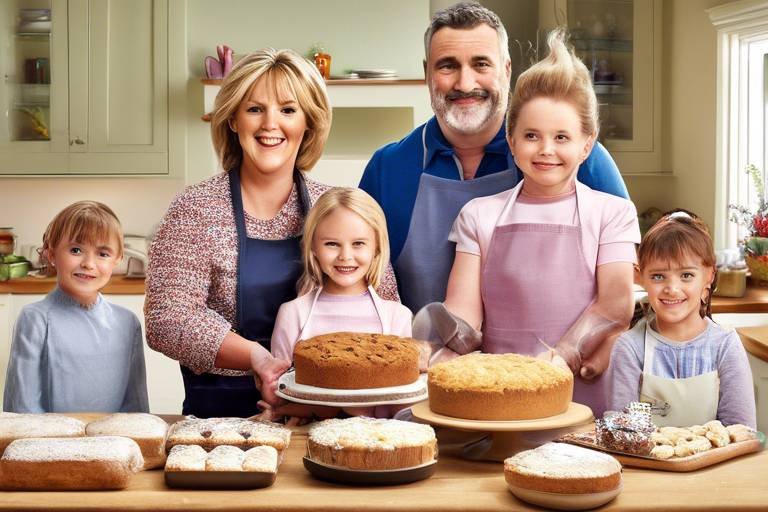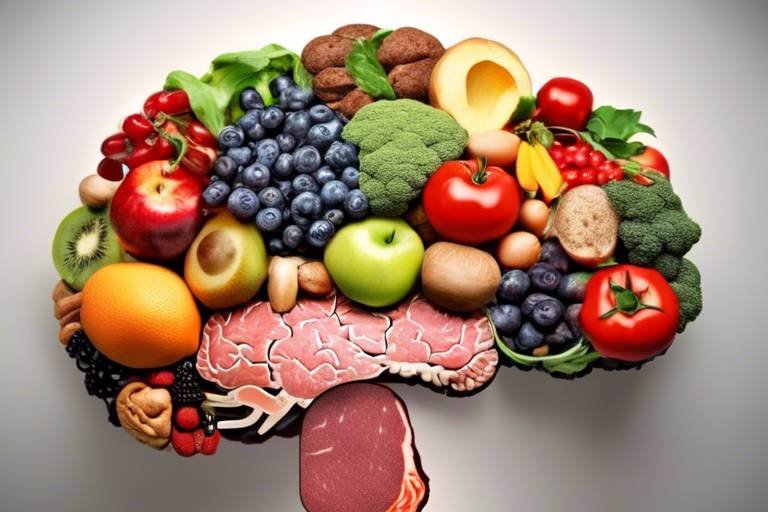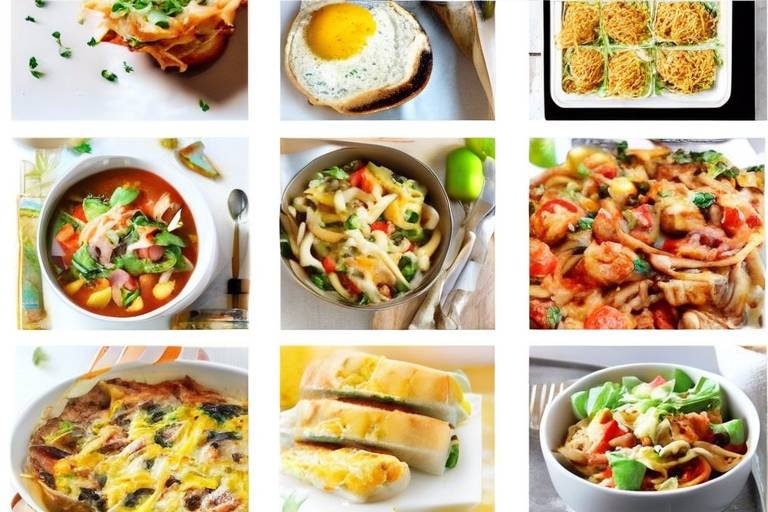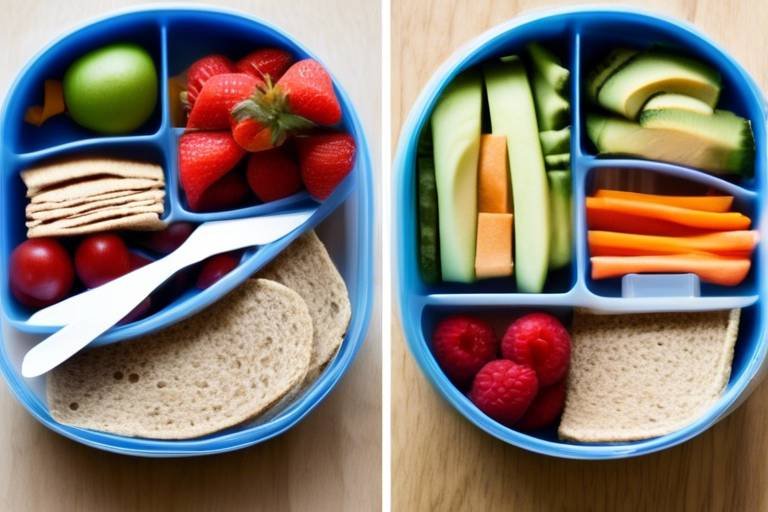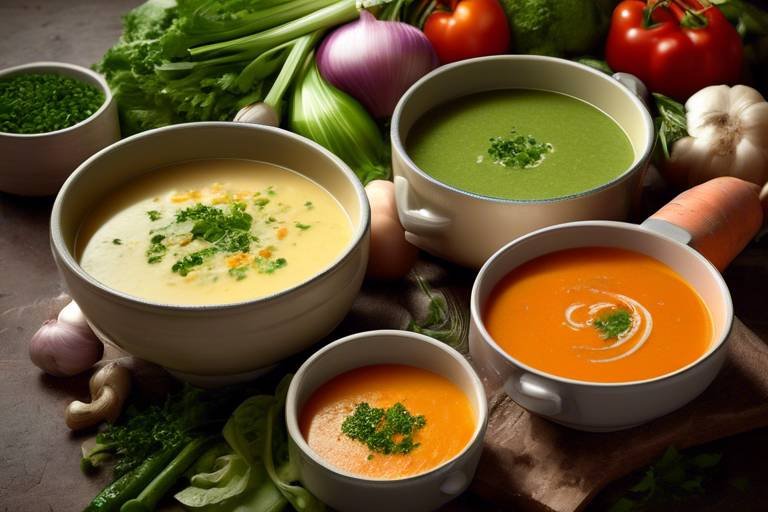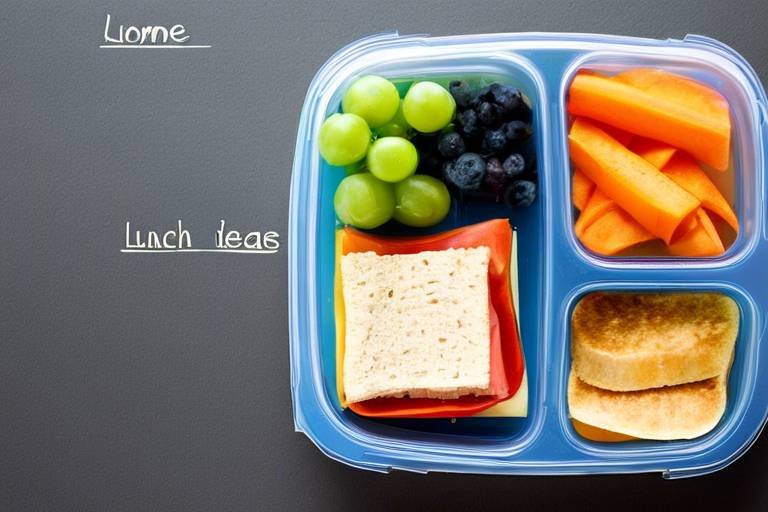Bake-Off: Healthy and Delicious Family Baking Recipes
Welcome to the delightful world of baking, where flavor meets health in the most scrumptious ways! Baking is not just a culinary task; it's a wonderful opportunity for families to bond, create memories, and indulge in treats that are both nutritious and delicious. Imagine the joy of gathering in the kitchen, flour dusting the air, and laughter echoing as you whip up healthy goodies together. This article is your ultimate guide to exploring a collection of nutritious yet tasty baking recipes that the whole family can enjoy together. We’ll dive into tips and techniques to make healthier choices without sacrificing flavor, ensuring that your family can relish every bite without any guilt!
Healthy baking offers numerous advantages that go beyond just satisfying your sweet tooth. First and foremost, it allows for improved nutrition. By choosing wholesome ingredients, you can pack your baked goods with essential vitamins and minerals. Moreover, healthy baking gives you better ingredient control. You can select what goes into your treats, steering clear of artificial additives and preservatives that often lurk in store-bought options. And let's not forget the sheer joy of creating wholesome treats! There’s something incredibly rewarding about mixing, measuring, and watching your creations rise in the oven, knowing they are not only delicious but also good for your family’s well-being.
Understanding which ingredients to use is key to successful healthy baking. Instead of traditional baking staples, consider alternatives that enhance nutrition while maintaining delicious flavors in your baked goods. For instance, using whole grains instead of refined flours can significantly boost the health benefits of your recipes. Whole grains are packed with nutrients and fiber, making them a far superior choice. But not all flours are created equal! Let’s explore the different types of flours you can use to elevate your baking.
Whole grains provide more nutrients and fiber compared to refined flours. When you choose whole grains, you’re not just opting for a healthier option; you’re also adding a rich, nutty flavor and a delightful texture to your baked goods. Imagine biting into a muffin that’s not only fluffy but also packed with the goodness of oats, whole wheat, or spelt. Incorporating whole grains into your recipes can improve the health benefits of your baked treats, making them a guilt-free pleasure!
Different flours have unique properties and nutritional profiles, which can impact the outcome of your baking. Whether you're looking for a light and fluffy cake or a dense, hearty bread, the right flour can make all the difference. Here’s a quick comparison of some popular flours:
| Flour Type | Texture | Nutritional Benefits |
|---|---|---|
| Whole Wheat Flour | Dense | High in fiber, vitamins, and minerals |
| Almond Flour | Nutty | Low in carbs, high in protein and healthy fats |
| Oat Flour | Soft | Rich in antioxidants and soluble fiber |
For those with gluten sensitivities, gluten-free baking can be delicious and satisfying. There are various gluten-free flours available, such as almond flour, coconut flour, and chickpea flour, each offering unique flavors and textures. With the right techniques, you can create tasty treats that everyone can enjoy, regardless of dietary restrictions. So, don’t shy away from experimenting with these alternatives!
Replacing refined sugars with natural sweeteners can enhance the health profile of your baked goods. Options like honey, maple syrup, and fruit purees not only add sweetness but also bring their own unique flavors and health benefits. Imagine a batch of brownies sweetened with ripe bananas or a cake drizzled with pure maple syrup. You’ll satisfy your sweet cravings without the guilt!
Now that you’re armed with knowledge about healthy ingredients, let’s dive into some simple yet delicious healthy baking recipes that are perfect for family bonding. These recipes are designed to be fun and easy for all ages to participate in, making your baking experience a joyful adventure!
Muffins can be a quick and healthy breakfast or snack option. Learn how to make nutritious muffins packed with fruits, vegetables, and whole grains that your family will love. Picture muffins bursting with blueberries or carrots, providing a delightful way to start the day!
Cookies can be made healthier with the right ingredients. Explore recipes for guilt-free cookies that satisfy sweet cravings while being lower in sugar and fat. Think of cookies that are crispy on the outside and chewy on the inside, made with wholesome oats and dark chocolate chips!
Achieving success in healthy baking requires some adjustments to traditional methods. Here are some essential tips that will help you create delicious, nutritious baked goods every time:
Accurate measurement is crucial for baking success. Learn the importance of measuring ingredients correctly and how it affects the texture and taste of your healthy baked goods. A little extra flour or a pinch less sugar can make a world of difference!
Don't be afraid to get creative! Experimenting with flavors and ingredients can lead to delightful surprises. Discover ways to incorporate spices, fruits, and nuts into your baking for added taste. Imagine a cinnamon-spiced bread or a chocolate chip cookie with a hint of orange zest!
- What are the best substitutes for sugar in baking? Natural sweeteners like honey, maple syrup, and agave nectar are great alternatives!
- Can I use whole wheat flour in all my recipes? Yes, but you may need to adjust the liquid ingredients as whole wheat flour absorbs more moisture.
- Are gluten-free baked goods less tasty? Not at all! With the right ingredients, gluten-free baking can be equally delicious.

[The Benefits of Healthy Baking]
Healthy baking is not just a trend; it's a delightful journey that can transform the way we think about food. When you choose to bake with health in mind, you're not only indulging in the pleasure of creating something delicious but also making a conscious decision to improve your family's well-being. Imagine the satisfaction of knowing that every bite of your homemade treats is packed with nutrients and flavor. This is the magic of healthy baking!
One of the most significant benefits of healthy baking is the control over ingredients. When you bake at home, you have the power to choose what goes into your recipes. This means you can avoid the artificial additives, preservatives, and excessive sugars often found in store-bought goods. Instead, you can incorporate wholesome ingredients like whole grains, natural sweeteners, and fresh fruits. This not only enhances the nutritional profile of your baked goods but also allows you to cater to any dietary restrictions your family may have.
Moreover, healthy baking fosters a sense of togetherness within the family. It's an activity that invites everyone to participate, from measuring ingredients to mixing batter. Imagine the laughter and joy as you all gather in the kitchen, creating memories while whipping up a batch of nutritious muffins or cookies. This shared experience can strengthen family bonds and teach children valuable lessons about cooking, nutrition, and the importance of making healthier choices.
Another fantastic aspect of healthy baking is its ability to promote better eating habits. When children are involved in the baking process, they are more likely to appreciate the food they create. They learn to love fruits and vegetables when they see them transformed into tasty treats. For instance, adding zucchini to muffins or using bananas in cookies can introduce them to new flavors and textures, making healthy eating more enjoyable.
Lastly, healthy baking can be a creative outlet. It encourages experimentation with flavors, textures, and ingredients. You can try out different combinations of spices, nuts, and fruits, leading to delightful surprises in your baked goods. This creativity not only makes baking fun but also allows you to discover new favorites that are both delicious and nutritious.
In summary, the benefits of healthy baking are vast and impactful. From improved nutrition and ingredient control to fostering family bonds and promoting better eating habits, the advantages are clear. So why not roll up your sleeves, preheat that oven, and dive into the world of healthy baking? Your taste buds and your family will thank you!

[Essential Ingredients for Healthy Baking]
When it comes to healthy baking, knowing which ingredients to choose is crucial. The right ingredients can transform your baked goods from mere indulgences into nutritious delights that your whole family will enjoy. Let's dive into the essentials that can help you achieve this balance of health and flavor.
One of the most significant shifts you can make in your baking is to replace traditional ingredients with healthier alternatives. For instance, instead of using all-purpose flour, consider incorporating whole grains into your recipes. Whole grains are not only more nutritious but also provide a rich, hearty flavor that enhances your baked treats. They are packed with fiber, vitamins, and minerals, making them a fantastic choice for muffins, breads, and cookies. Here’s a quick comparison of common flours:
| Type of Flour | Nutritional Benefits | Best Uses |
|---|---|---|
| Whole Wheat Flour | High in fiber and nutrients | Breads, muffins, pancakes |
| Almond Flour | Low in carbs, high in healthy fats | Baking, breading |
| Coconut Flour | High in fiber, gluten-free | Breads, cookies |
| Oat Flour | Rich in antioxidants | Pancakes, cookies |
For those who are gluten-sensitive, don't worry! There are plenty of gluten-free options available that can still produce delicious results. Flours made from almonds, coconut, or rice are excellent substitutes that not only cater to dietary needs but also add unique flavors and textures to your baked goods. Just remember, when using gluten-free flours, the texture might differ slightly, so be ready to experiment a bit!
Another critical component of healthy baking is the choice of sweeteners. Instead of reaching for refined sugars, opt for natural sweeteners that not only add sweetness but also come with added nutrients. Honey, maple syrup, and fruit purees are fantastic alternatives that can enhance the flavor profile of your recipes while keeping the sugar content in check. For example, using mashed bananas or applesauce in your muffins can provide moisture and sweetness without the extra calories.
Lastly, don't forget about adding healthy fats! Instead of using butter or margarine, consider alternatives like avocado, Greek yogurt, or nut butters. These ingredients can add creaminess and richness to your baked goods while providing a boost of nutrients. Imagine biting into a muffin that's not only delicious but also packed with healthy fats that keep you feeling satisfied!
In summary, the key to successful healthy baking lies in choosing the right ingredients. By incorporating whole grains, natural sweeteners, gluten-free options, and healthy fats, you can create baked goods that are both nutritious and delicious. So roll up your sleeves, gather your ingredients, and get ready to bake up some wholesome treats that your family will love!
Q: Can I substitute all-purpose flour with whole wheat flour in any recipe?
A: While you can substitute whole wheat flour for all-purpose flour, it may alter the texture. Start by replacing half and adjust based on your preference.
Q: What are some good natural sweeteners for baking?
A: Popular natural sweeteners include honey, maple syrup, agave nectar, and fruit purees like applesauce or mashed bananas.
Q: Are gluten-free baked goods less nutritious?
A: Not necessarily! Gluten-free flours can be nutritious, especially when made from whole foods like nuts and grains. Just be mindful of the overall ingredients used in the recipe.
Q: How can I make my baked goods moist without using too much fat?
A: Incorporating ingredients like yogurt, applesauce, or mashed bananas can add moisture without excessive fat.

[Whole Grains vs. Refined Flours]
When it comes to baking, the choice between whole grains and refined flours can significantly impact not only the flavor and texture of your baked goods but also their nutritional value. Whole grains are essentially grains that contain all parts of the grain kernel: the bran, germ, and endosperm. This means they are packed with fiber, vitamins, and minerals that are crucial for maintaining a healthy diet. On the other hand, refined flours have been processed to remove the bran and germ, leaving mostly the starchy endosperm. This process strips away much of the grain's natural goodness, making refined flours less nutritious.
Why does this matter for your family's health? Well, incorporating whole grains into your baking can lead to numerous benefits. For starters, whole grains are known to improve digestion and help maintain a healthy weight. They provide sustained energy, making them a great choice for kids and adults alike. Imagine the difference between a cookie made with whole wheat flour versus one made with all-purpose flour. The former not only offers a more robust flavor but also keeps you feeling fuller for longer, reducing the temptation for unhealthy snacks later on.
To illustrate the differences in nutritional content, let’s take a look at a simple comparison:
| Nutrient | Whole Grain (1 cup cooked) | Refined Flour (1 cup cooked) |
|---|---|---|
| Calories | 150 | 200 |
| Fiber | 6g | 2g |
| Protein | 6g | 4g |
| Iron | 1.5mg | 0.5mg |
As you can see, whole grains win hands down when it comes to fiber and protein content, both of which are essential for a balanced diet. But how can you start incorporating more whole grains into your baking? It’s easier than you think! You can substitute whole wheat flour for all-purpose flour in most recipes at a 1:1 ratio, although you might want to start with a blend of both if you're new to whole grains. This way, you can gradually introduce your family to the flavor and texture of whole grains without overwhelming their taste buds.
Don’t forget about the versatility of whole grains! They come in many forms, such as oats, brown rice, and quinoa, which can be used in a variety of baked goods. Whether you’re making muffins, bread, or even pancakes, experimenting with these ingredients can lead to delightful and nutritious results. So next time you’re in the kitchen, consider reaching for whole grains instead of refined flours. Your family’s health—and their taste buds—will thank you!
- Can I use whole grain flour in any recipe? Yes, most recipes can be adapted to use whole grain flour, but you may need to adjust the liquid content slightly.
- What is the best way to store whole grain flour? Store whole grain flour in an airtight container in a cool, dark place to maintain its freshness.
- Are there any gluten-free whole grain options? Yes, options like quinoa flour, brown rice flour, and buckwheat flour are great gluten-free alternatives that are also whole grains.

[Choosing the Right Flour]
When it comes to healthy baking, choosing the right flour is like picking the perfect canvas for your masterpiece. Each type of flour brings its own unique flavor, texture, and nutritional benefits to your baked goods. But how do you know which flour to use? The answer lies in understanding the differences between various flours and how they can impact your recipes.
First off, let’s talk about whole wheat flour. This flour is made from the entire grain, which means it retains all of its natural nutrients and fiber. Whole wheat flour adds a nutty flavor and a denser texture to your baked goods, making it a fantastic option for breads and muffins. However, if you’re looking for something lighter, consider using white whole wheat flour. It’s milled from a lighter variety of wheat and offers the same health benefits as traditional whole wheat flour but with a milder taste.
Another popular choice is almond flour, which is perfect for gluten-free baking. Made from finely ground almonds, this flour adds a lovely richness to your treats while being lower in carbs. It’s a great option for cookies and cakes. If you're experimenting with gluten-free recipes, you might also want to explore coconut flour. It's highly absorbent, so you’ll need to adjust your liquid ingredients accordingly, but it imparts a subtle sweetness and works wonderfully in pancakes and muffins.
Now, let’s not forget about oat flour. This flour is made from ground oats and is another excellent gluten-free option. Oat flour brings a mild, slightly sweet flavor, making it great for cookies and pancakes. You can even make your own oat flour at home by blending rolled oats in a food processor until they reach a fine powder consistency. How cool is that?
To help you navigate the world of flours, here’s a quick comparison table:
| Flour Type | Texture | Nutritional Benefits | Best For |
|---|---|---|---|
| Whole Wheat Flour | Dense | High in fiber and nutrients | Breads, muffins |
| White Whole Wheat Flour | Light | Same as whole wheat but milder | Breads, pancakes |
| Almond Flour | Nutty | Low in carbs, high in healthy fats | Cookies, cakes |
| Coconut Flour | Soft | High in fiber, low in carbs | Pancakes, muffins |
| Oat Flour | Mild | Rich in fiber, gluten-free | Cakes, pancakes |
Ultimately, the key to successful healthy baking is to experiment and find the flour that works best for your recipes and taste preferences. Mixing flours can also yield delightful results. For instance, combining almond flour with whole wheat flour can create a wonderfully moist and nutritious cake. Remember, the right flour can elevate your baking from ordinary to extraordinary!
- Can I substitute all-purpose flour with whole wheat flour in my recipes?
Yes, you can! However, it’s best to start by replacing half of the all-purpose flour with whole wheat flour to see how the texture and flavor change. - Is almond flour a good substitute for all-purpose flour?
Absolutely! Almond flour is a great gluten-free option, but remember to adjust your liquids since it absorbs more moisture than regular flour. - How do I store different types of flour?
Store your flours in a cool, dry place. Whole grain and nut flours should ideally be kept in the refrigerator to prevent them from going rancid.

[Gluten-Free Options]
For many, the joy of baking can be overshadowed by dietary restrictions, particularly gluten sensitivity or celiac disease. However, the good news is that gluten-free baking can be just as delightful and satisfying as traditional baking! The secret lies in choosing the right ingredients and techniques to ensure your baked goods are not only safe to eat but also delicious.
When it comes to gluten-free flours, there are several fantastic options available. Each type of flour has its unique flavor and texture, so experimenting with different blends can lead to some exciting results. Here are some popular gluten-free flours you might consider:
- Almond Flour: Made from finely ground almonds, this flour adds a rich, nutty flavor and is excellent for cookies and cakes.
- Coconut Flour: This flour is highly absorbent and works well in recipes that require moisture. It’s perfect for pancakes and muffins.
- Rice Flour: A staple in gluten-free baking, rice flour has a neutral flavor and is often used in combination with other flours.
- Oat Flour: Ground from gluten-free oats, this flour adds a wholesome taste and is great for breads and cookies.
One of the most effective strategies for gluten-free baking is to use a flour blend. Many commercial gluten-free flour blends combine various flours and starches to mimic the properties of wheat flour. This can help achieve a similar texture and rise in your baked goods. It's also essential to incorporate a binding agent, such as xanthan gum or psyllium husk, to help your dough hold together.
Moreover, don’t shy away from adding flavor enhancers! Gluten-free baked goods can benefit immensely from the addition of spices, vanilla extract, or citrus zest. These ingredients can elevate the taste and make your treats even more enjoyable. For instance, a sprinkle of cinnamon in your gluten-free muffins can create a warm, inviting aroma that fills your kitchen with comfort.
Lastly, remember that gluten-free baking often requires a bit of patience and experimentation. Don’t get discouraged if your first batch doesn’t turn out perfectly. Just like any other skill, mastering gluten-free baking takes practice. With time, you’ll discover the best combinations and techniques that work for you and your family.
Q: Can I substitute regular flour with gluten-free flour in any recipe?
A: Not always! Gluten-free flours behave differently than wheat flour, so it’s best to follow recipes specifically designed for gluten-free baking or use a flour blend designed for substitutions.
Q: What can I use as a binding agent in gluten-free baking?
A: Common binding agents include xanthan gum, guar gum, and psyllium husk. These help to provide structure and elasticity to gluten-free baked goods.
Q: Are gluten-free baked goods healthier than traditional ones?
A: Not necessarily. While gluten-free options can be beneficial for those with gluten sensitivities, some gluten-free products can be high in sugar and fat. Always check the ingredient labels and opt for whole food ingredients when possible.

[Natural Sweeteners]
When it comes to baking, one of the biggest challenges is finding ways to make our treats healthier without sacrificing that delightful sweetness we all crave. This is where natural sweeteners come into play! Unlike refined sugars, which can spike our blood sugar levels and contribute to various health issues, natural sweeteners provide a range of benefits that can enhance both the flavor and nutritional profile of your baked goods.
Natural sweeteners, such as honey, maple syrup, and fruit purees, are not only delicious but also come packed with vitamins, minerals, and antioxidants. For instance, honey is known for its antibacterial properties and can add a rich flavor to your recipes. Maple syrup, on the other hand, contains essential nutrients like manganese and zinc, making it a fantastic alternative to traditional sugar. And let’s not forget about fruit purees! They can add moisture and natural sweetness to your baked goods while also sneaking in some extra fiber.
Here’s a quick comparison of some popular natural sweeteners:
| Sweetener | Flavor Profile | Nutritional Benefits |
|---|---|---|
| Honey | Rich, floral | Antioxidants, antibacterial properties |
| Maple Syrup | Earthy, sweet | Manganese, zinc, antioxidants |
| Agave Nectar | Light, mild | Low glycemic index |
| Fruit Purees (e.g., applesauce) | Fruity, sweet | Vitamins, fiber |
When using natural sweeteners, it’s important to remember that they can vary in sweetness and moisture content compared to refined sugars. For example, if you’re substituting honey for sugar, you might want to reduce the amount slightly since honey is generally sweeter. And because some natural sweeteners add moisture, you may need to adjust your liquid ingredients accordingly to achieve the perfect texture in your baked goods.
One of the best things about using natural sweeteners is the opportunity to experiment with flavors. You can mix and match different sweeteners to find the perfect balance for your recipes. Have you ever tried using mashed bananas in your cookie dough? Not only does it add a delightful sweetness, but it also makes your cookies moist and chewy!
Ultimately, the journey of incorporating natural sweeteners into your baking is all about finding what works best for you and your family. It’s a fun way to get creative in the kitchen while promoting a healthier lifestyle. So, the next time you’re whipping up a batch of brownies or muffins, consider reaching for a natural sweetener instead of that traditional sugar. Your taste buds—and your body—will thank you!
- Can I substitute sugar with natural sweeteners in any recipe?
While many recipes can accommodate natural sweeteners, you may need to adjust the amounts and other ingredients to maintain the desired texture and flavor. - Are natural sweeteners healthier than refined sugars?
Generally, yes! Natural sweeteners often contain additional nutrients and have a lower glycemic index than refined sugars, making them a better choice for overall health. - How do I know how much natural sweetener to use?
Start by using about ¾ of the amount of sugar called for in the recipe and adjust to taste. Remember, some natural sweeteners are sweeter than sugar!

[Easy Healthy Baking Recipes]
Baking with the family can be one of the most enjoyable activities, especially when you have a collection of easy healthy recipes at your fingertips. Imagine the aroma of fresh muffins wafting through the house or the sight of colorful cookies lined up on the cooling rack. These moments not only create delicious treats but also foster bonding and memories that last a lifetime. So, let’s dive into some delightful recipes that are not only nutritious but also incredibly easy to whip up!
First up, we have Nutritious Muffins. Muffins are a fantastic option for breakfast or snacks, and they can be loaded with wholesome ingredients. You can easily incorporate fruits like bananas or blueberries, and even sneak in some vegetables like grated carrots or zucchini. Here's a simple recipe to get you started:
| Ingredients | Quantity |
|---|---|
| Whole wheat flour | 1 ½ cups |
| Baking powder | 2 tsp |
| Honey or maple syrup | ½ cup |
| Milk (or almond milk) | 1 cup |
| Eggs | 2 |
| Fruits/Vegetables (like mashed bananas or grated zucchini) | 1 cup |
This recipe is as simple as mixing the dry ingredients in one bowl and the wet ingredients in another, then combining them and folding in your fruits or vegetables. Bake at 350°F (175°C) for about 20-25 minutes, and you’ll have a batch of fluffy, nutritious muffins that your family will adore!
Next, let’s talk about Guilt-Free Cookies. Who doesn’t love cookies? The good news is that you can satisfy your sweet tooth without the guilt. By using healthier substitutes, you can create cookies that are lower in sugar and fat. Here’s a quick recipe:
For these cookies, you can use ingredients like almond flour or oats instead of refined flour, and swap out refined sugar for natural sweeteners like coconut sugar or applesauce. Here’s what you’ll need:
- 1 cup almond flour
- ½ cup oats
- ¼ cup coconut sugar
- 1/3 cup unsweetened applesauce
- 1 tsp vanilla extract
- ½ tsp baking soda
Mix all the ingredients in a bowl, scoop out small amounts onto a baking sheet, and bake them at 350°F (175°C) for about 10-12 minutes. You’ll end up with chewy, delicious cookies that everyone will love!
These easy healthy baking recipes not only make for delightful treats but also serve as a wonderful opportunity for family bonding. Whether you’re measuring ingredients or mixing bowls, the kitchen becomes a space for creativity and laughter. Plus, you’ll be instilling healthy eating habits in your children, showing them that nutritious food can also be incredibly tasty!
Q: Can I substitute regular flour with whole wheat flour in all recipes?
A: While you can substitute whole wheat flour for regular flour in most recipes, it may alter the texture slightly. It’s often best to start with a 50/50 mix and adjust from there.
Q: Are there any egg substitutes for vegan baking?
A: Yes! You can use flaxseed meal mixed with water, applesauce, or mashed bananas as egg substitutes in baking.
Q: How can I make my baked goods less sweet?
A: Reducing the amount of sugar in a recipe is one way, but you can also incorporate naturally sweet ingredients like ripe bananas or applesauce to maintain flavor while cutting back on added sugars.

[Nutritious Muffins]
Muffins are not just a tasty treat; they can also be a nutritious powerhouse for your family. Imagine starting your day with a muffin that not only satisfies your sweet tooth but also packs a punch of fiber, vitamins, and minerals. The beauty of muffins lies in their versatility. You can easily incorporate fruits, vegetables, and even whole grains to create a healthy snack or breakfast option that everyone will love. Think of them as a blank canvas, just waiting for you to unleash your creativity!
One of the best things about making nutritious muffins is that you can customize them to suit your family's tastes. For instance, if your kids love bananas, why not whip up some banana oat muffins? Or perhaps you have a stash of blueberries that need to be used? Blueberry muffins are a classic favorite! By using whole grain flours, such as whole wheat or oat flour, you can boost the fiber content significantly, making these muffins more filling and healthier.
Another fantastic tip is to sneak in some veggies. Yes, you heard that right! Grated carrots or zucchini can be added to your muffin mix without anyone being the wiser. This not only enhances the moisture of the muffins but also adds an extra layer of nutrition. It’s like a stealthy little health hack! Plus, you can sweeten your muffins naturally by using ingredients like applesauce or honey instead of refined sugar, making them even more wholesome.
To make your muffin-making journey even smoother, here’s a quick table of nutritious muffin ingredients you can consider:
| Ingredient | Benefit |
|---|---|
| Whole Wheat Flour | Higher fiber content, aids digestion |
| Oats | Rich in antioxidants, helps lower cholesterol |
| Greek Yogurt | High in protein, adds moisture |
| Fruit Purees | Natural sweetness, lowers added sugar |
| Nuts and Seeds | Healthy fats, adds crunch and flavor |
So, the next time you’re in the kitchen, consider whipping up a batch of these nutritious muffins. Not only will you be treating your family to something delicious, but you’ll also be fueling their bodies with the nutrients they need to thrive. It’s a win-win situation! And remember, baking is all about having fun, so don’t hesitate to experiment with different flavors and ingredients. Who knows? You might just stumble upon your family's new favorite muffin!
Q: Can I make muffins without eggs?
A: Absolutely! You can substitute eggs with mashed bananas, applesauce, or even flaxseed meal mixed with water for a vegan option.
Q: How can I store my muffins to keep them fresh?
A: Store your muffins in an airtight container at room temperature for up to 3 days. For longer storage, consider freezing them.
Q: Can I use gluten-free flour in muffin recipes?
A: Yes! Many gluten-free flours like almond flour or coconut flour can be used. Just be sure to adjust the liquid content accordingly.

[Guilt-Free Cookies]
Who says cookies have to be a guilty pleasure? With a few simple adjustments, you can whip up guilt-free cookies that satisfy your sweet tooth without compromising your health goals. Imagine sinking your teeth into a warm, chewy cookie that not only tastes amazing but also packs a nutritional punch. Sounds too good to be true? Let’s dive into how you can make this a reality!
First off, the key to creating these delightful treats lies in substituting traditional ingredients with healthier alternatives. For instance, instead of using all-purpose flour, consider using whole wheat flour or even almond flour. These options are not only rich in nutrients but also provide a wonderful texture that complements your cookies perfectly. Whole wheat flour is packed with fiber, which can help keep you feeling full longer, making it an excellent choice for those late-night cravings.
Next, let’s talk about sweeteners. Refined sugars can add empty calories to your cookies, but by swapping them out for natural sweeteners, you can enhance the flavor while keeping your cookies healthy. Options like
- Honey - a natural humectant that keeps cookies moist
- Maple Syrup - adds a unique flavor profile
- Banana Puree - a great way to add sweetness and moisture
Now, you might be wondering about the fat content. Instead of butter, which can be high in saturated fat, consider using coconut oil or unsweetened applesauce. These alternatives not only reduce the overall fat content but can also add unique flavors to your cookies. For example, coconut oil brings a subtle tropical taste, while applesauce keeps your cookies moist and adds a hint of sweetness.
Here’s a simple recipe to get you started on your guilt-free cookie journey:
| Ingredient | Amount |
|---|---|
| Whole Wheat Flour | 1 cup |
| Oats | 1/2 cup |
| Honey | 1/3 cup |
| Coconut Oil (melted) | 1/4 cup |
| Dark Chocolate Chips (optional) | 1/4 cup |
| Egg | 1 |
| Baking Soda | 1/2 tsp |
| Vanilla Extract | 1 tsp |
To make these cookies, simply mix all the ingredients in a bowl, scoop them onto a baking sheet, and bake at 350°F (175°C) for about 10-12 minutes. The result? Delicious, chewy cookies that everyone in the family will love—without the guilt!
Incorporating these guilt-free cookies into your family baking sessions not only makes for a fun activity but also teaches kids that healthy choices can be delicious. So, gather the family, roll up your sleeves, and start baking! You’ll be amazed at how satisfying it is to enjoy a treat that’s both wholesome and tasty.
Q: Can I substitute the honey in the recipe?
A: Absolutely! You can use maple syrup or agave nectar as alternatives. Just keep in mind that the sweetness level may vary slightly.
Q: Are these cookies suitable for gluten-free diets?
A: Yes! You can easily substitute the whole wheat flour with a gluten-free flour blend or almond flour to make them gluten-free.
Q: How can I store these cookies?
A: Store them in an airtight container at room temperature for up to a week, or freeze them for longer storage. Just make sure to separate layers with parchment paper to prevent sticking!

[Tips for Successful Healthy Baking]
When it comes to healthy baking, a few key tips can make all the difference in ensuring your treats are not only nutritious but also delicious. First and foremost, measuring ingredients accurately is crucial. Unlike cooking, where you can often eyeball ingredients, baking is a science. The right balance of ingredients can mean the difference between a fluffy muffin and a dense brick. Invest in a good kitchen scale and measuring cups to help you get it just right. Remember, precision is your best friend in the kitchen!
Another tip is to experiment with flavors. Don’t be afraid to get creative! Baking is an art as much as it is a science, and the beauty lies in the ability to personalize your recipes. Adding spices like cinnamon or nutmeg can elevate the flavor profile of your baked goods. Additionally, incorporating fruits, nuts, or even vegetables can introduce new textures and flavors. For instance, shredded carrots or zucchini can be a fantastic addition to muffins, making them moist and packed with nutrients.
Furthermore, consider the substitutions you can make to enhance the healthiness of your recipes. Instead of using all-purpose flour, try mixing in some whole wheat flour or almond flour. These alternatives not only boost the nutritional value but also add a unique flavor. Similarly, when it comes to sweeteners, swapping out refined sugar for natural sweeteners like honey, agave syrup, or mashed bananas can significantly improve the health profile of your treats.
Lastly, be mindful of the baking temperature and time. Lowering the oven temperature by 25°F can help prevent over-browning while allowing your baked goods to cook evenly. Keep a close eye on them, as healthier ingredients may change the cooking time slightly. Remember, every oven is different, so it's essential to know your appliance and adjust accordingly.
In summary, successful healthy baking is about precision, creativity, and making informed ingredient choices. With these tips in mind, you can create delicious baked goods that your whole family will love, without compromising on health!
Q: Can I substitute regular flour for whole wheat flour in any recipe?
A: While most recipes can accommodate whole wheat flour, it’s best to start by substituting half of the all-purpose flour with whole wheat flour to see how it affects the texture and taste.
Q: What are some good natural sweeteners to use?
A: Some popular natural sweeteners include honey, maple syrup, agave nectar, and date sugar. Each has its unique flavor, so feel free to experiment!
Q: How can I make my baked goods moist without using too much sugar?
A: Incorporating ingredients like applesauce, yogurt, or mashed bananas can add moisture without the need for excessive sugar.
Q: Is gluten-free baking really different from traditional baking?
A: Yes, gluten-free baking often requires different techniques and ingredients. Gluten-free flours behave differently, so it’s important to follow recipes specifically designed for gluten-free baking.

[Measuring Ingredients Accurately]
When it comes to baking, precision is key. Imagine you’re trying to build a house; if the measurements are off, the whole structure could collapse. The same principle applies to baking! Accurate measurement of ingredients can make the difference between a fluffy cake and a dense brick. So, how do you ensure that you’re measuring correctly? Let’s dive into the essentials!
First, it’s important to understand the difference between dry and liquid measurements. Dry ingredients like flour and sugar are typically measured using dry measuring cups, while liquids like milk and oil should be measured in a clear liquid measuring cup with a spout. This distinction helps maintain accuracy, as dry ingredients can be packed down, leading to discrepancies if measured incorrectly. For instance, a cup of flour can weigh anywhere from 120 to 150 grams depending on how it's scooped. To avoid this, always use the spoon-and-level method: spoon the flour into the measuring cup and level it off with a straight edge.
Another crucial aspect of measuring accurately is using a kitchen scale. A scale is your best friend in the world of baking! It allows you to measure ingredients by weight, which is far more reliable than volume. For example, if a recipe calls for 200 grams of sugar, using a scale will ensure you get it just right, whereas a cup measurement might lead to variations. If you don’t have a scale, consider investing in one; it’s a small price to pay for consistent baking results.
Additionally, be mindful of how you measure ingredients like brown sugar. This ingredient should be packed into the measuring cup for accurate results, while things like powdered sugar should be sifted before measuring to prevent clumping. Here’s a quick reference table to help you remember the correct measuring techniques for common ingredients:
| Ingredient | Measuring Technique |
|---|---|
| Flour | Spoon into cup and level off |
| Sugar | Same as flour, but brown sugar should be packed |
| Butter | Use a scale or the stick markings |
| Liquid Ingredients | Use a liquid measuring cup |
| Powdered Sugar | Sift before measuring |
Finally, don’t forget to check your ingredient temperatures. Ingredients like butter and eggs should be at room temperature unless specified otherwise. Cold ingredients can affect how they blend together, leading to uneven textures in your final product. Think of it like trying to mix cold butter into a warm batter; it just doesn’t work well!
In conclusion, measuring ingredients accurately is a fundamental skill for successful baking. By using the right tools, understanding the differences in measurement, and keeping an eye on ingredient temperatures, you can ensure that your baked goods turn out just as delicious as you envision them. So, grab your measuring cups and scale, and let’s get baking!
- Why is accurate measurement important in baking? Accurate measurement ensures that the chemical reactions in baking occur as intended, leading to the desired texture and flavor.
- What is the best way to measure flour? Use the spoon-and-level method: spoon the flour into your measuring cup and level it off with a straight edge.
- Should I always use a scale for baking? While not mandatory, using a scale can greatly improve accuracy and consistency in your baking.
- How do I measure brown sugar correctly? Brown sugar should be packed firmly into the measuring cup to ensure you’re using the right amount.

[Experimenting with Flavors]
When it comes to healthy baking, one of the most exciting aspects is the opportunity to experiment with flavors. Don't be afraid to step outside the box and combine various ingredients that can elevate your baked goods to new heights! Think of your kitchen as an artist's palette, where you can mix and match to create something truly unique and delicious. Imagine the aroma of freshly baked goods infused with spices or the delightful surprise of a hidden fruit layer. Sounds enticing, right?
One of the simplest ways to add flavor is by incorporating spices. Cinnamon, nutmeg, and ginger can transform a standard muffin into a warm, comforting treat. For instance, adding a teaspoon of cinnamon to your banana bread not only enhances the flavor but also brings a cozy, inviting scent that fills your home. Have you ever tried adding a pinch of cardamom? It’s like a warm hug for your taste buds!
Fruits can also play a starring role in your baking adventures. Consider using fruit purees as a natural sweetener or moisture enhancer. Applesauce, for example, can replace oil in many recipes, making them healthier without compromising on taste. You can also fold in fresh or dried fruits, like blueberries or cranberries, to add bursts of flavor and nutrition. Imagine biting into a muffin and discovering pockets of juicy blueberries—pure bliss!
And let’s not forget about nuts and seeds. They not only add a delightful crunch but also pack a nutritional punch. Walnuts, almonds, or chia seeds can provide healthy fats and proteins, making your baked goods more satisfying. You could sprinkle some chopped nuts on top of your cookies or mix them into your batter for added texture. It’s like giving your treats a little extra personality!
To inspire your flavor experimentation, here’s a quick table of flavor pairings that work wonders together:
| Base Ingredient | Flavor Pairing | Why It Works |
|---|---|---|
| Banana | Cinnamon | Warm spice complements the sweetness of bananas. |
| Chocolate | Sea Salt | Salt enhances the richness of chocolate, creating a balanced flavor. |
| Carrot | Ginger | Spicy ginger adds warmth and depth to sweet carrots. |
| Apple | Nutmeg | Nutmeg adds a warm, earthy flavor that complements the tartness of apples. |
Remember, the key to successful flavor experimentation is to start small. A little bit of spice or a handful of nuts can go a long way. Taste your batter as you go along; after all, baking is as much about the journey as it is about the destination. Who knows? You might just stumble upon your family’s new favorite recipe! So, gather your ingredients, unleash your creativity, and let the flavors dance together in harmony!
Q: Can I substitute regular flour with whole wheat flour in my recipes?
A: Absolutely! Whole wheat flour can be used in most recipes, but it may require slight adjustments in liquid content due to its higher absorbency.
Q: How can I make my baked goods stay moist?
A: Incorporating ingredients like applesauce, yogurt, or mashed bananas can help retain moisture in your baked goods.
Q: What are some good gluten-free flour options?
A: Popular gluten-free flours include almond flour, coconut flour, and gluten-free all-purpose flour blends. Each has its own unique taste and texture, so feel free to experiment!
Q: How do I know if my baking is healthy?
A: Look for recipes that use whole ingredients, natural sweeteners, and healthy fats. The less processed, the better!
Frequently Asked Questions
- What are the benefits of healthy baking?
Healthy baking offers a multitude of benefits, such as improved nutrition and better ingredient control. It allows you to create delicious treats without the guilt, ensuring that your family enjoys wholesome snacks. Plus, it brings everyone together in the kitchen, creating cherished memories as you bake together!
- What ingredients should I use for healthy baking?
For healthy baking, consider using whole grains, natural sweeteners, and healthier fats. Whole wheat flour, oats, and almond flour are great alternatives to refined flours. Natural sweeteners like honey, maple syrup, or mashed bananas not only add sweetness but also provide additional nutrients!
- How can I make gluten-free baked goods?
Making gluten-free baked goods is easier than you might think! You can use gluten-free flours like almond flour, coconut flour, or rice flour. Combining these with ingredients like eggs and yogurt can help achieve a great texture. Don't forget to check your baking powder and other ingredients to ensure they're gluten-free!
- Can I substitute sugar in my baking recipes?
Absolutely! You can replace refined sugar with natural sweeteners such as honey, maple syrup, or even fruit purees. These alternatives can enhance the flavor of your baked goods while reducing added sugars. Just remember to adjust the amount of liquid in your recipe accordingly!
- What are some easy healthy baking recipes I can try with my family?
There are plenty of easy and fun recipes to try! Nutritious muffins loaded with fruits and veggies are a hit, as are guilt-free cookies made with oats and dark chocolate. You can even experiment with healthy brownies using black beans or sweet potatoes for added nutrition!
- How important is measuring ingredients accurately in baking?
Measuring ingredients accurately is crucial for successful baking. It affects the texture and taste of your treats. Using a kitchen scale can help ensure you're getting the right amounts, especially when it comes to flour and sweeteners. Trust me, your baked goods will thank you!
- Can I experiment with flavors in healthy baking?
Definitely! Don't shy away from experimenting with flavors. Adding spices like cinnamon or nutmeg, or incorporating fruits and nuts can elevate your baked goods. It's all about finding that perfect balance that suits your family's taste buds!

